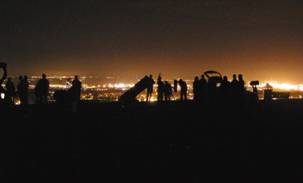AFA Star Parties: Opposition of Mars 2003
By Dr Russell Cockman
To commemorate the closest approach of Mars to Earth for 60,000 years during National Astronomy Week in late August 2003, the Association of Falkirk Astronomers held a series of star parties at Wallace's Monument, Wallacestone, from the 23rd August to the 30th August. The site was chosen because of its proximity to Falkirk, good southerly aspect, elevated position and extensive area for setting up telescopes and for parking cars. The events were advertised in local papers, on Central FM, on posters in regional library notice boards and on the BP Grangemouth Intranet site.
The success of the star parties can be summed up in one word'WOW!! For our planning and preparation we were rewarded by an unexpectedly strong response from the public who were clearly captivated by the rarity of this extremely close encounter with Mars. An estimated 360 visitors attended the parties exceeding our wildest expectations by far. Saturday the 29th was the busiest night with a genuine festival atmosphere as visitors arrived fully rugged-up against the anticipated chill, tea/coffee flasks in hand, and set up deck chairs to enjoy the views in comfort. Visitors queued up to observe through the four telescopes that were in operation whilst others milled about discussing what they had seen and asking probing questions of the experts present!
And the weather played its part! Incredibly, six out of the eight nights were sufficiently clear for useful observation'and thirty five visitors arrived on one of the cloudy nights, the night of closest approach! They missed viewing Mars (though several returned on a later night), but discussion about all things astronomical was lively and entertaining. As a bonus, viewing comfort generally was high as conditions were surprisingly mild, still and essentially dew-free. Most nights a few visitors arrived early and waited expectantly for the planet's first appearance in the SE. The tension was almost organic.

Mars was the observing target that became better placed as the evening wore on. Although atmospheric seeing was generally poor due to the low elevation, moments of stiller air allowed the south polar cap to glow radiantly in the eyepiece and light and dark markings snapped into focus. Without exception, visitors departed content that they had witnessed a rare encounter. They had also sampled some of what the night sky had to offer as the opportunity was taken to show visitors a range of objects through a range of equipment to demonstrate just what is observable from populated areas. Among the objects examined were the Andromeda Galaxy, the Ring Nebula, M13, Brocchi's cluster in Vulpecula, The Double Cluster in Perseus, The Pleiades, Milky Way star fields in Cygnus, double stars (b Cygni, Mizar and Alcor, n Draconis, e Lyrae, o2 Cygni) as well as Vega, Arcturus, Capella and m Cephei that were used to highlight the subtle colours of stars. At times the band of the Milky Way could also be faintly discerned overhead.
Many thanks go to Falkirk Council for allowing us to use the site out of hours and to all the AFA members who supported the event with their energy and enthusiasm.
We plan to hold more public viewing sessions later this year, or early next year, to view Saturn, Jupiter, Venus and the Moon and to demonstrate the wealth of impressive deep sky objects found in the winter sky.